Spending too much time on manual tasks? Customer services frustratingly slow? Using too many workarounds to overcome disconnected processes? Reporting taking weeks or months, instead of hours or minutes? If any of these sound like you, then now’s the time to integrate.
Integration is a big topic and can be dauntingly complex, even if you live and breathe technology. Building a business case and getting the green light for investing in an enterprise integration strategy invariably requires you to brush up on the latest approaches, clarify the ‘what, why, and how’ – and outline the challenges you can expect along the way.
So, to make life easier, we’ve answered all the questions most asked (and you’re welcome to use them in your proposal or discussion paper).
A plain language guide to enterprise integration
What is enterprise integration exactly? Put simply, enterprise integration is the art of connecting everything (not just one or two applications) in your IT landscape together. This allows the disparate technologies, clouds, applications, networks, and devices used throughout your enterprise to exchange information that would normally be locked away or hard to share and analyse.
What’s in it for you? The ‘why is it important’ of enterprise integration is an easy sell. Complete IT system integration delivers the benefits of added productivity and efficiency. But critically, integration also enables access to all the information locked away in individual applications and line-of-business systems - empowering informed and timely decision-making. As always, knowledge is power. Read more about integration in our blog Digital plumbing: Building the foundation for your digital success. Enterprise integration plays a critical role in enabling and driving digital transformation and operational efficiency. Here’s how:
Information not data

Moving data between systems can be a complex task, and requires duplication of the business rules used to interpret, manage and govern it. If the data can be accessed in a way that provides information then this creates an easier integration experience. This removes the need for further processing of the data, and any business logic needing to be stored outside of the domain that owns this.
Enable employee productivity and engagement
By connecting applications and synchronising data, a change made in one application is pushed to all related systems — automatically. When you integrate software, you can eliminate tedious, unproductive tasks so your employees can focus on more valuable business activities like spending more time with customers, improved reporting and forecasting, and uncovering new trends and opportunities to grow.
To err is human
We all make mistakes. However, even a small error can deliver an impact out of all proportion to the initial mistake. Interpreting data manually can be costly and risky — from a wrongly placed decimal point to under or overcharging customers to underestimating operational expenses. Integration minimises the opportunity for human errors by processing the data automatically.
Automate use cases
Once you’ve integrated your environment, you can identify opportunities to automate business processes like customer or staff onboarding, application processing, account payable approvals, service management, marketing-driven customer communications, and more. Both staff and customer satisfaction levels improve when supported by a swift, smooth and responsive process.
More protection of the things that matter
Information access is a sensitive matter. It’s critical that only those who are authorised can view and use information sensitive to your company, employees, customers and partners. Taking an enterprise approach to maintaining data security with integration enables compliance with data protection and privacy regulations, the ability to pass security audits, and the high degree of governance demanded by key stakeholders.
Unimpeded growth, agility and innovation
The ability to rapidly change processes and direction and adapt to an ever-changing (and always challenging) market are the hallmarks of a mature and successful organisation. Enterprise integration provides you with the agility to respond to new initiatives, as well as leverage technologies like AI and IoT (internet of things) — especially when your integration strategy has prioritised interoperability.
What does ‘no integration’ look like?
Imagine this:
One of your customers has opened a new retail outlet. The store’s details need to be added to your system for deliveries, invoicing, and sales/support in your pick/pack/logistics solution, financial/invoicing application, and CRM (customer relationship management). But if these applications aren’t integrated, you need to do this manually – three times, and maybe even by three different departments.
Outcome:
Triple the work and cost. Triple the opportunity for error. Triple the time to update applications.
Why is integration so critical to modern business operations?
Enterprise integration is more than just a technological solution. It’s now considered a strategic imperative for modern businesses.
Here’s why. Integration not only enables you to reduce costs, synchronise your data, and facilitate collaboration and communication but also empowers your organisation to achieve operational excellence, meet its business goals and objectives, and stay ahead of your competitors.
Today, when done well, integration is regarded as a business enabler that adds value to your existing technological ecosystem and (over) delivers on outcomes, service capabilities, and new opportunities that will justify your investment.
But wait – what’s interoperability when it’s at home?
Interoperability is the icing on the integration cake. Systems integration by itself means that your solutions can exchange information but not necessarily understand (and therefore use) it without manual intervention. Which tends to defeat the purpose of the exercise, right?
However, if you prioritise interoperability when developing your integration strategy, your solutions not only talk to one another effortlessly but don’t need an interpreter to translate between them. They speak the same language, so no manual interventions are required – either now or as you add further solutions to your environment.
What are some common integration use cases?
Here are just five examples – but rest assured, there are many, many more!
- Make your information work harder
- Supercharge your business processes
- Revitalise your technology environment
- Take advantage of innovation (and drive it!)
- Control your cloud
OK, let’s talk about risk
We live in a risk-averse world, and with good reason. We’ve all worked too hard over some very tough years to knowingly endanger our businesses. Yet, that’s what can happen when we don’t leverage integration.
Some of the (avoidable) risks experienced by organisations that lack integration include:
Decision-making you’ll regret
Disconnected systems can make it difficult to get a comprehensive view of your business operations. Without the full picture of your past and present data, it’s all too easy to make the wrong decisions – even with the best intentions.
Security loopholes
Disconnected systems can increase the complexity of your security measures. Without a consistent way to control your security over your entire landscape, your business is more vulnerable to cyber threats.
Worrying workflows
In-house development can lead to inefficient workflows and processes. For example, if a critical issue arises with your data integration, there could be a risk of data loss or inaccurate data.
The ‘what’s what’ of enterprise integration?
Enterprise integration uses several techniques, tools and technologies, including:
What are some of the typical challenges of enterprise integration?
Interoperability is nearly always the biggest roadblock in any enterprise integration project. Issues can include the quality and format of your interfaces, governance integrity, and complex information mapping and transformation requirements.
Security, as ever, is always a risk in any major technology project. These risks include data exposure, data encryption, data protection and compliance with privacy regulations, and auditing/monitoring.
The diversity, age and nature of existing systems also present challenges, as do the limitations of API integration.
And, of course, the shortage of talented, experienced and trained resources adds to the mix.
How do we overcome enterprise integration challenges?

Data security
One of the keys to overcoming challenges in terms of integration security is making it easy to implement. A good API gateway will support standardised identity and access management, and ensure consumers can only access the services they are supposed to access. Where more granular access controls are required (such as attribute-based or context-based access controls), these can be implemented at the service level or in the system of record.
API gateways are also an excellent tool for simplifying encryption in transit, as most provide excellent support for managing TLS certificates. Your consumers can interact with endpoints that are secured by popular third-party certificate authorities, while you have the option to manage traffic between the gateway and your services with certificates signed by your own CA.
For auditing and monitoring purposes, applying best practice in terms of correlation identifiers can ensure traceability of traffic across your various services and systems of record.
Diversity, age and nature of existing systems
Any large enterprise – any enterprise, really – is going to have some applications which don’t support the full spread of modern integration patterns. There are a variety of options to overcome these challenges. One popular approach is to wrap legacy applications in a service layer which exposes data in modern ways. For instance, if a legacy application does not provide RESTful APIs, one can be implemented in the service layer, either translating from an older API specification (such as SOAP) or by interacting with the application’s database. An additional benefit of this approach is that it can simplify the migration process to a modern application. Once the service layer is in place, your tech crew can start mapping the API to a new application, supporting the seamless transition from old to new.
Shortage of talented, experienced and trained resources
Skilled integration resources are always in short supply. This is where partnering with a System Integrator company (like Fusion5) can really help your business. We are able to provide talented staff to increase your staff velocity, execute digital transformation initiatives, and provide training to your in-house staff. Whether you’re looking to maintain a full in-house team, or you’re eager to leverage a partner to augment your integration capability, Fusion5 can help you.
What’s hot? Popular enterprise integration platforms and technologies
Enterprise Application Integration (EAI) platforms enable the streamlining and automating of workflows and processes, as well as the exchange of data between applications and services — regardless of your underlying technologies and data formats. They effectively bridge the gap between your software, databases, and business processes.
Some of the world’s leading technology vendors offer comprehensive and feature-rich platforms and services in the EAI space.
Popular platforms and services include:
- Microsoft Azure Integration Services for secure integration and governance of applications, systems, and data. It includes over 600 out-of-the-box connectors and services, Azure security and governance, low-code business-process automation, and app integration services.
- Amazon Web Services (AWS) offers a range of fully managed services for application integration, enabling communication between decoupled components within microservices, distributed systems, and serverless applications.
- Oracle Cloud Infrastructure (OCI) Integration Services connects a wide range of applications and data sources, automates end-to-end processes and centralises management. OCI offers application integration and low-code automation for rapid connectivity, as well as numerous prebuilt adapters.
- IBM App Connect Enterprise enables the seamless flow of business information between various applications across different hardware and software platforms. It serves as a powerful Integration Platform-as-a-Service (iPaaS) that can be deployed on-prem and on multiple cloud platforms, including AWS.
How do you choose the right enterprise integration platform?
You’ll be pleased to know it’s never guesswork. We apply primary evaluation criteria to your business case, including whether it meets your data management maturity, functionality and user experience, scalability, flexibility, compatibility, data governance, security, support, and user experience needs.
No two of our customers ever have the same environments, business challenges, and use cases, so we take a vendor-agnostic approach to help select the right technology stack. We’re all about the fit.

Best practices in enterprise integration
Best practice in enterprise integration can look different for different enterprises. For enterprises with a small IT team and limited technology service offerings for their customers, an integration platform as a service (iPaaS) may be a sensible option. A good iPaaS can ensure centralised command and control of your integration landscape. This can make it easy to implement standard authentication and authorisation, security, and performance.
For enterprises that have a higher digital maturity can consider a microservices architecture. Whereas an iPaaS can provide simplicity and standardised controls, a microservices architecture can provide enhanced flexibility and scalability, while also reducing licencing costs. However, the skills and effort required to maintain microservices may be higher than an iPaaS approach.
Fusion5’s experts can help you to understand which is the correct solution approach for your enterprise. We have twenty years of experience in supporting enterprises to develop integration strategies that cater to their specific needs.
What are the key considerations in enterprise application integration?
Having a well-understood integration strategy is key to developing a fit-for-purpose enterprise application integration landscape. By defining your strategic integration goals, we can set out the principles, processes and techologies that will support your business to move in the right direction.
Once you have your strategy defined, you can then develop an enterprise integration reference architecture. This is where you define the patterns for implementing various types of integration (such as push/pull, synchronous/asynchronous, real-time/scheduled, etc). This provides the detail that solution designers and developers need to build your integrations in a consistent fashion.
Your integration reference architecture will also help you to define the baseline qualities of your integrations, such as scalability, security, useability, and resiliency.
Developing an integration strategy and reference architecture is a hugely important piece of work for ensuring efficient enterprise integration, but it can be quite daunting for even highly experienced technical specialists. Fusion5 has been assisting customers with this work for the past two decades, so we know the tricks as well as the pitfalls. Feel free to reach out to us to see how we can accelerate your integration strategy and reference architecture.
Fusion5’s approach to integration
One of our key principles to integration is “One size does not fit all”. The integration needs of a small or medium sized business are not necessarily going to be the same as a large enterprise. Likewise, the nature of your business and your combination of in-house skills may influence the integration technologies and patterns you should implement. We take the time to understand your business context, and help you to develop strategies and solutions that meet the needs of your customers, your staff, and your business.
For instance, do you have a solid footprint in a particular cloud service provider? We can develop cloud-native integrations that leverage the tools from your preferred provider. Are you trying to keep your options open? We can design a multi-cloud or hybrid cloud integration landscape for you, taking advantage of “best-of-breed” technologies. Do you want to keep things simple? An iPaaS may the the right solution. Are you looking for maximum flexibility? We can develop a fully bespoke integration service suite for you. In all cases, we ensure that we deliver solutions that are secure and robust and will grow with your business so you can take advantage of new opportunities.
One more option that deserves a mention is our Campfire integration offering. This “integration as a service” approach provides a fully managed integration suite specifically tailored for your business. This is perfect for customers who don’t want to have to worry about any integration concerns and want everything to “just work”. We design, build, deploy and maintain your integrations for you. No more upgrades, no more upskilling, no more hassle — it’s all taken care of. Please reach out to us if you’d like to know more about Campfire or any other integration approach that we specialise in.
Is enterprise integration on your mind? Let’s talk. Whether you just want to find out more about what we do and some of our success stories or discuss strategies or services, we’d love to hear from you.
Frequently asked questions
When does it make sense to implement integration?
Who benefits from enterprise integration?
The question really should be: Who doesn’t? Your business leaders will love having real-time and complete data to make decisions, your workers will be delighted to say goodbye to tedious manual processes and data entry – and the ability to ‘makes things happen’ (like onboarding and IT support) at the touch of a button, and your customers will be impressed with your speed of response and efficiency. Then there are your partners, stakeholders, and investors. Everyone is a winner with integration.
What is iPaaS vs. IaaS? How do they relate to integration?
While IaaS (infrastructure as a service) and iPaaS (integration platform as a service) both, in effect, enable the same thing (i.e. they help businesses integrate their applications, sources of data, and systems), they are distinct cloud computing models.
-
IaaS is the foundation for creating a cloud-based service – it provides virtualised computing resources.
-
iPaaS enables the integration of your applications and services.
What is an example of enterprise application integration?
Just one example? Okay – consider creating a single ecosystem for your accounting, HR, ERP, inventory management and CRM. So, all the data can flow between these differing technologies, and you can enable automated processes – from easy onboarding of new customers or employees to creating reports showing the impact of ongoing relationship management on sales.
What are the four major enterprise applications?
- ERP (enterprise resource planning)
- CRM (customer relationship management)
- SCM (supply chain management)
- Knowledge management systems
What are the major challenges of enterprise integration?
Major challenges include maintaining and ensuring the security of your information and apps, ensuring interoperability due to the variety of software tools and data repositories, managing and optimising growing volumes of data, supporting flexibility and growth, data quality, and the diverse nature of the systems to be integrated.



